| Columns Retired Columns & Blogs |
I've purchased Paradigm Studio 60 V5 with Marantz SR7005 AVR for Stereo setup. Is this combination is correct ?
Regards
shashi
The Paradigm Reference Studio 60 v.5 is specified as having a voltage sensitivity of 89dB, but with no drive voltage given. My estimate of its sensitivity on the speaker's tweeter axis was a little higher, at 90dB(B)/2.83V/m, which is usefully higher than average. The Paradigm will play at satisfyingly high levels with relatively low-powered amplifiers. Its impedance (fig.1) remains between 5 and 8 ohms over most of the audioband, though a minimum magnitude of 3.6 ohms at 185Hz and a combination of 5 ohms and –37° electrical phase angle at 110Hz mean that the amplifier used should be capable of dealing with 4 ohm loads.
Other than the glitch at 25kHz, which is associated with the tweeter's primary dome resonance, the traces in fig.1 are free from the small wrinkles that would indicate the existence of cabinet panel resonances of various kinds. Nevertheless, investigating the vibrational behavior of the side panels with a simple plastic-tape accelerometer, I did find a couple of relatively strong resonant modes, at 242 and 380Hz (fig.2). The levels of these modes varied considerably according to where on the side panel I placed the accelerometer, so it's probable that the affected radiating areas aren't large enough to color the sound. Indeed, Kal Rubinson noted that he could detect no cabinet resonances.
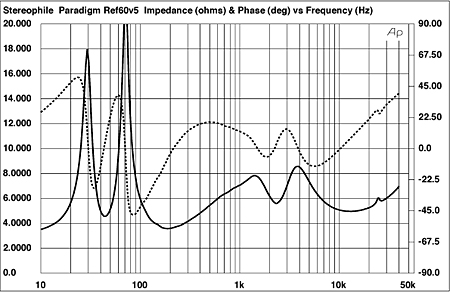
Fig.1 Paradigm Reference Studio 60 v.5, electrical impedance (solid) and phase (dashed). (5 ohms/vertical div.)
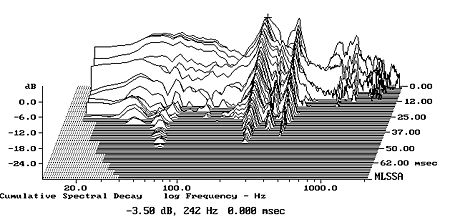
Fig.2 Paradigm Reference Studio 60 v.5, cumulative spectral-decay plot calculated from output of accelerometer fastened to side panel level with rear port (MLS driving voltage to speaker, 7.55V; measurement bandwidth, 2kHz).
The saddle centered on 42Hz in the plot of impedance magnitude (fig.1, solid trace) suggests that this is the tuning frequency of the midrange unit and the twin woofers, and this was, indeed, the frequency of the minimum-motion notch in both the midrange unit's and the upper woofer's outputs. However, the lower woofer appears to be tuned to a slightly lower frequency. The front and rear ports behave very similarly, and their summed output, adjusted for the different distances from a nominal farfield microphone position, is shown as the red trace in fig.3; it peaks between 30 and 90Hz, and the upper-frequency rolloff is commendably free from any resonant spikes.
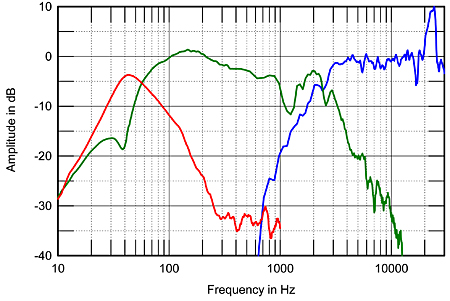
Fig.3 Paradigm Reference Studio 60 v.5, acoustic crossover on tweeter axis at 50", corrected for microphone response, with nearfield responses of midrange/woofers (blue) and ports (red) plotted below 350Hz and 1kHz, respectively.
The green trace below 350Hz in fig.3 shows the summed response of the three lower-frequency units. It broadly peaks in the upper bass, most of which will be an artifact of the nearfield measurement technique. Above 350Hz, the green trace shows the farfield response of the woofers and midrange unit on the tweeter axis. The crossover to the tweeter occurs around 2.5kHz rather than the specified 2kHz, but there is a suspicious-looking suckout between 1000 and 1500Hz. This measurement was taken with sample 48488; when I checked the other speaker of the pair (serial number 48489), it behaved similarly, though the suckout was a couple of 2dB less severe. I can only assume that the suckout results from destructive interference between the midrange unit and the woofers on this axis and at this microphone distance.
The tweeter (blue trace) rolls in above 2.5kHz and is basically flat within its passband. The ultrasonic peak, due to the drive-unit's primary dome resonance, covers a wider bandwidth than usual but doesn't affect frequencies below 20kHz. In this respect, the Reference 60 v.5's tweeter looks very similar to that of the Reference Studio 20, which Robert J. Reina reviewed in May 2008, and which actually had two closely spaced ultrasonic resonances.
Fig.4 shows the Studio 60 v.5's farfield response with the grille in place, averaged across a 30° horizontal window on the tweeter axis and spliced to the complex sum of the lower-frequency nearfield responses at 300Hz. The suckout at 1300Hz is still evident, though it does cover a narrow bandwidth. The apparent response boost in the upper bass is again due, in part, to the nearfield measurement technique, but it does appear that the Studio 60 v.5 has a fairly generous low-frequency response with useful extension to 35Hz. This bass is balanced by the tweeter's output. I would have suspected from this graph that the Paradigm's treble would sound rather forward—though KR felt that he got "a greater sense of presence from many recordings," overall he found the speaker's high end to sound "natural and transparent." The effect of the grille (not shown) was to reduce the tweeter's output slightly, with additional but slight losses of energy in the 3–5kHz and 8–12kHz regions. However, because the grille's plastic molding continues the smooth contour of the surfaces adjacent to the drive-units, I performed all the farfield acoustic measurements with it in place.
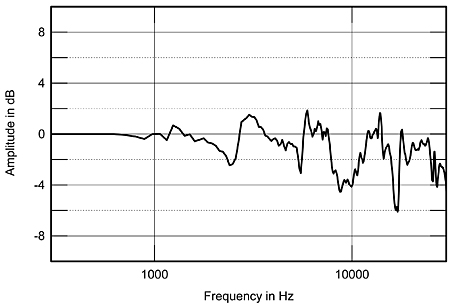
Fig.4 Paradigm Reference Studio 60 v.5, anechoic response on tweeter axis at 50", averaged across 30° horizontal window and corrected for microphone response, with complex sum of nearfield woofer and port responses plotted below 300Hz.
Fig.5 shows the Studio 60 v.5's vertical dispersion, normalized to the response on the tweeter axis. This axis is 38.5", compared to the typical ear height of a seated listener of 36", and it can be seen that the tweeter-axis suckout in the upper midrange does progressively fill in at lower heights. (KR noted in an email that he does sit lower than the usual 36".) Laterally (fig.6), the Paradigm's dispersion is wide and even, given that the apparent peakiness that develops off axis is actually due to dips in the on-axis response filling in to the speaker's sides.
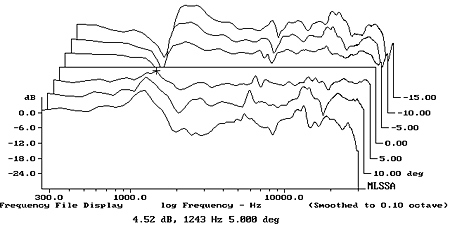
Fig.5 Paradigm Reference Studio 60 v.5, vertical response family at 50", normalized to response on tweeter axis, from back to front: differences in response 15–5° above axis, reference response, differences in response 5–15° below axis.
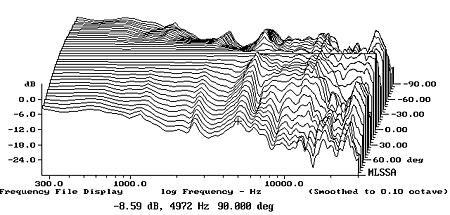
Fig.6 Paradigm Reference Studio 60 v.5, lateral response family at 50", normalized to response on tweeter axis, from back to front: differences in response 90–5° off axis, reference response, differences in response 5–90° off axis.
In the time domain, the Studio 60 v.5's step response on the tweeter axis (fig.7) suggests that all four drive-units are connected with the same positive acoustic polarity, and though the tweeter's output (the sharply defined up/down spike starting at 3.7ms) leads that of the other units, the overshoot of its step smoothly blends with the rise of the midrange unit's and woofers' step. The "bumpiness" of the latter between 4 and 5ms is presumably due to the multiple arrivals at the measuring microphone of the individual outputs on this axis, and gives rise to the measured lack of energy in the upper midrange. This suckout can also be seen in the Paradigm's cumulative spectral-decay plot on the tweeter axis (fig.8), but this graph is otherwise quite clean. There is also very little delayed energy associated with the ultrasonic resonance.
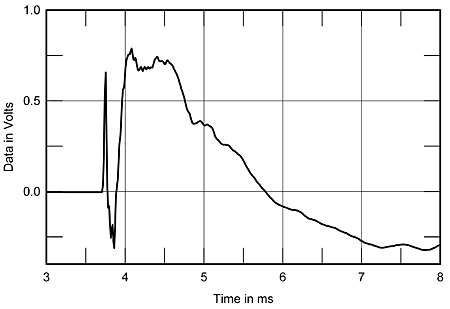
Fig.7 Paradigm Reference Studio 60 v.5, step response on tweeter axis at 50" (5ms time window, 30kHz bandwidth).
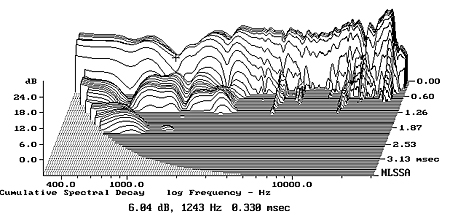
Fig.8 Paradigm Reference Studio 60 v.5, cumulative spectral-decay plot on tweeter axis at 50" (0.15ms risetime).
"I can't think of any parameter in which the Reference Studio 60 v.5 is not a significant advance on its predecessors," writes KR of the sound of this well-engineered Paradigm. The same can be said of the loudspeaker's measured performance, other than its need for the listener to sit below the tweeter axis to get the optimal transition through the upper midrange.—John Atkinson

I've purchased Paradigm Studio 60 V5 with Marantz SR7005 AVR for Stereo setup. Is this combination is correct ?
Regards
shashi